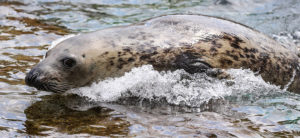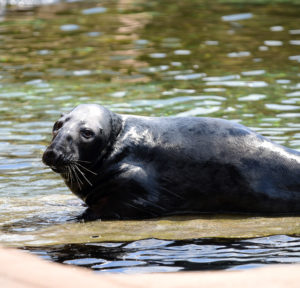Sparkling pools of water…
Icy glaciers in the background…
The sharp sound of sea lions barking as they frolic and play…
This spacious, state-of-the-art exhibit was designed to house sea lions and seals. With 108,000 gallons of recycled saltwater in the main pool, they are enjoying leisurely days of swimming, playing, and basking in their new digs.
Zoo visitors are enjoying some creature comforts of their own. With both above-ground and underwater viewing available it is possible to see these fascinating animals from almost any angle. A 200 seat amphitheater provides shaded seating for daily training and enrichment presentations.
Fun Facts About the Exhibit
- The Seal and Sea Lion habitat has the potential to hold a total of 14 seals and sea lions.
- The habitat’s state-of-the-art outdoor pool holds 110,000 gallons of saltwater.
- The pool depth ranges from 0 feet in the shallow end to 9 feet in the deep end.
- The chilled saltwater temperature never goes above 65 degrees.
- The saltwater is recirculated through high-rate sand filters and ozone systems.
- We get 25 tons of salt at a time to make brine. The brine is then added to the water for the seal and sea lion pool to acclimate the 110,000-gallon pool to the desired salinity. Salinity concentration is tested by staff on a daily basis using a digital refractometer. Seawater salinity is 32 parts per thousand. Drinking water has a salinity of fewer than 0.5 parts per thousand. Saltwater is equivalent to about 5 ounces of salt in 1 gallon of water.
- The spacious, shaded seating for visitors in the amphitheater seats 200.
- Most of the “wood” you see in the exhibit is in fact concrete painted to look like weathered wood.
Meet the Seals and Sea Lions
Glacier Run has the potential to house a total of 14 seals and sea lions. So far, the following pinnipeds call it their home (although more will join the group over time).
Riva
- Female California Sea Lion
- Born in 2014 and relocated to the Louisville Zoo in 2015.
- Stranded on the California coast and rescued.
- Relocated to the Louisville Zoo from the California Wildlife Center.
- Very energetic and is referred to by staff as a “rocket”.
- Learn more about Riva in our Trunkline article.
- See more information about Riva’s rescue in our Press Release.
Gremlin
- Female California sea lion
- Born August 6, 2003
- Relocated to the Louisville Zoo in 2013 from Miller Park Zoo in Bloomington, IL.
Tonie
- Female Harbor seal
- Born in 2002
- She was relocated in 2010 to the Louisville Zoo from Lincoln Children’s Zoo in Nebraska
Oscar
- Male Harbor Seal
- Born in 2011
- Relocated to the Louisville Zoo in 2018 from Miller Park Zoo in Bloomington, IL.
Finsbay

- Male gray seal
- Born December 28, 2020
- Now integrated with the group and on exhibit rotation!
- Curious and playful
- Pup of Boone and Rona
Rona

- Female Gray seal
- Born in 2014 at the Smithsonian National Zoo
- Relocated to the Louisville Zoo in 2016
- Mother of seal pup Finsbay
Boone
- Male Gray seal
- Born in 2004 from Chicago’s Brookfield Zoo
- Came to the Louisville Zoo in May 2018.
- He has a distinguishable arched nose.
- Father of Finsbay
Minnow
- Male Gray seal
- Born in 1988
- From Chicago’s Brookfield Zoo
- Came to the Louisville Zoo in May 2018
What is the difference between seals and sea lions?
Seals and sea lions are in the pinniped family. Pinnipeds are aquatic carnivorous mammals that have a streamlined body specialized for swimming with limbs modified as flippers. Here are some ways to tell the difference between a seal and sea lion:
Sea Lions
- Considered the acrobats of the ocean
- Have earflaps
- Have long hairless front flippers
- Have long smooth whiskers or vibrissae
- Their hind flippers rotate underneath to allow them to be agile and walk quickly on land
- They swim underwater using front flippers like the wings of a bird
Seals
- Have ear holes
- Have short, hairy front flippers & long claws
- They move on land by pulling themselves with front flippers and keeping their hind flippers straight out (like an inchworm – keeping their bellies to the ground).
- They swim by steering with four flippers and powering with hind flippers







